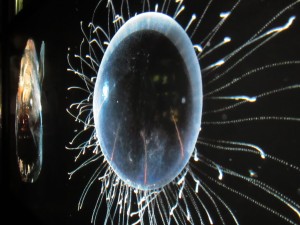The waters from 1000m to 4000m deep is categorised as Bathypelagic Zone.

In this zone, temperatures here no longer exceed 4° Celsius. It is impossible to detect any light, and food sources have been drastically reduced too. The easiest food to obtain would be the crumbs falling from the shallower waters; however majority of them would have already been eaten by the many organisms residing in the first kilometre. It would be impractical to swim up to obtain more food as it is too far away from the shallower waters too.
How do marine creatures at this zone survive then?
In order to adapt to this hostile environment, some of the animals here are static creatures with slow metabolisms. Rather than using force or speed, they resort to tricks to find their meals. Others have adapted by exhibiting unique body characteristics, such as gigantic jaws, and highly elastic stomach which can accommodate a prey larger than itself.


Overall, animals living at this seemingly inhospitable zone have adapted extraordinarily.
Lastly, there is the abyssopelagic zone.